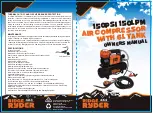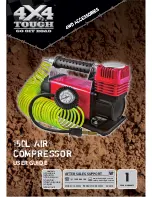
8510197P02-C © Danfoss Commercial Compressors May-2006
Instructions
•
For compressors equipped with Rotolock, remove
the Teflon gaskets when brazing Rotolock connec-
tors with the solder sleeve and be aware that original
suction and discharge gaskets must be replaced.
•
When installing Rotolock fittings, always use
two wrenches when tightening any fittings to
ensure that the torque is effectively cancelled
on the adjacent tubing and fittings. Do not ex-
ceed the maximum tightening torque for Roto-
lock connections to the compressor. (1’’ Rotolock
80Nm - 1’’1/4 Rotolock 90Nm 1’’3/4 Rotolock
110Nm - 2’’1/4 Rotolock 130Nm).
•
Be sure to connect the required safety and control
devices onto compressor shutoff valves or fittings.
•
In case of oil return through the Schrader fitting
on the compressor shell, make sure the internal
valve is removed.
5 – Leak �e�e����n
Never use oxygen or dry air in order to avoid
the risk of fire or explosion.
•
Perform a leak detection test on the complete sys-
tem by means of: a dry nitrogen pressure test, a mix-
ture of nitrogen and the refrigerant to be used in the
system, a helium leak test and/or a deep vacuum test.
•
The test should be long enough in duration to en-
sure the absence of any slow leaks in the system.
•
Use tools specifically designed for detecting leaks.
•
The low side test pressure must not exceed 25
bars for SM, SY, SZ compressors, 30 bars for the
SH 180 - 240 - 300 compressors and 33 bars for
SH 090 - 120 - 161 compressors.
•
For high side test pressure recommendations,
please refer to the Application Guidelines.
•
Whenever the compressor is equipped with
suction and discharge shut-off valves, these val-
ves are to remain in the closed position while
performing the leak test (compressor leak test
already performed in the factory).
•
Should a leak be discovered, proceed with re-
pair steps and repeat the leak detection.
•
When a deep vacuum leak detection test is se-
lected, observe the following:
1) The level to reach is 500 μm Hg. Wait 30 min.
2) If pressure increases rapidly, the system is
not airtight. Locate and repair leaks. Restart the
vacuum procedure, followed by steps 1, 2, etc.
3) If pressure increases slowly, the system
contains moisture inside. Break the vacuum with
nitrogen gas and restart the vacuum procedure,
followed by steps 1, 2, etc.
4) Connect the compressor to the system by
opening the valves.
5) Repeat the vacuum procedure, followed by
steps 1, 2, etc.
6) Break the vacuum with nitrogen gas.
7) Repeat the vacuum procedure, steps 1,2; a
vacuum of 500 μm Hg (0.67 mbar) should be rea-
ched and maintained for 4 hours. This pressure is
to be measured in the refrigeration system, not at
the vacuum pump gauge.
Do not use a megohmeter or apply power to the
compressor while it is under vacuum, as this may
cause motor winding damage (motor burn-out).
Do not use colored leak detection fluids. Do
not use chlorofluorocarbon in leak testing sys-
tems designed for HFC fluids.
6 - Va���m p���e���e
Whenever possible (if shut-off valves are pre-
sent), the compressor must be isolated from the
system. It is essential to connect the vacuum
pump to both the LP & HP sides, in order to avoid
dead-ending system parts.
Recommended procedure:
1) Once leak detection has been completed,
pull down the system under a vacuum of 500 μm
Hg (0.67 mbar).
2) When the vacuum level of 500 μm Hg has been
reached, the system must be isolated from the pump.
3) A vacuum of 500 μm Hg (0.67 mbar) has to be
reached and maintained for 4 hours. This pressure is
to be measured in the refrigeration system, not at
the vacuum pump gauge.If pressure increases, res-
tart the leak-detection procedure (refer to the
“Leak
detection”
section of this manual if necessary).
Vacuum pump:
A two-stage vacuum pump with gas ballast (0.04-
mbar standing vacuum) shall be used; its capacity
is to be consistent with system volume.Never use
the compressor as a vacuum pump. It is recommen-
ded to use large-diameter connection lines and to
connect these lines to the shutoff valves, rather than
to the Schrader connection. This recommendation
allows avoiding excessive pressure losses.
Moisture level:
At the time of commissioning, system moisture
content may be as high as 100 ppm. During ope-
ration, the liquid line filter dryer must reduce this
level to < 20 ppm.
Additional notes:
•
To improve moisture removal, the temperature
of the system should not be lower than 10°C.
• A proper vacuum procedure is even more important
with HFC and polyolester lubricant than it has “tradi-
tionally” been with HCFC (R22) or CFC and mineral oil.
•
For further details, please refer to TI bulletin 1-026.
Do not use a megohmeter or apply power to the
compressor while it is under vacuum, as this may
cause motor winding damage (motor burn-out).
7 - Ele�����al ��nne����ns
•
Make sure the main power supply to the system
has been switched off and isolated, in accordance
with applicable regulations, before performing
any electrical connection.
•
Refer to Figs. 7, 8, 9 for wiring connection details
with respect to the various motor codes.
•
Note that Performer® compressors SM/SZ 115
- 125 - 160 - 175 - 185 are provided with a bime-
tallic single pole single throw thermostat which
is located in the motor windings. Because the
thermostat is an automatic reset device, it must
be wired in a lockout safety circuit with a manual
reset to restart the unit (refer to Fig. 8). For over-
current protection, an external manual reset
overload protector must be used.
•
Note that Performer® compressors SM/SZ 084
- 090 - 100 - 110 - 120 - 148 - 161 and SH 090 - 120 -
161 are protected against overheating and overloa-
ding by an internal safety motor protector. Howe-
ver, an external manual reset overload protector
is recommended for protecting the circuit against
over-current (Fig . 7).
•
SY/SZ 240 - 300 - 380 and SH 240 - 300 motors
are protected by an external module protecting
against phase loss/reversal, overheating and
high current draw (Fig. 9).
•
The SH 180 motor is protected by a external
module protecting against overheating and high
current draw (Fig 10).
•
The “must trip” value of these overload relays
must be set in accordance with power line sizing
and design and shall never exceed the “A max.”
value stamped on the nameplate.
•
Performer is a unidirectional machine and will
only pump refrigerant when properly phased. The
SM/SZ 084 to 185 and the SH 180 compressors in-
corporate an internal reverse rotation protection
to safeguard the compressor. If reverse rotation
occurs, shut the compressor down and connect
phases to the proper terminals. If reverse rotation
is not halted, the compressor will cycle off on the
internal motor protection. For the SY/SZ 240 - 300
- 380 and SH 240 - 300 compressors, a phase se-
quence controller function is built into the exter-
nal motor protection module (Refer to Fig. 9).
• Compressor models SH090 - 120 - 161 have no
internal reverse rotation protection. If reverse ro-
tation occurs it will be obvious as soon as power
is turned on. The compressor will not build up
any pressure, the sound level will be abnormally
high and power consumption will be minimal. In
such case, shut down the compressor immedia-
tely and connect the phases to their proper ter-
minals. Although reverse rotation is not destruc-
tive for the SH 090 - 120 - 161 for a short period of
time, prolonged reverse rotation over 6 hours will
damage the compressor.
•
The power supply connection is made by means
of a T-block connector (screw type 4.8 mm -
3/16”) and the thermostat connection is made by
means of a spade connector (1/4”-AMP-AWE). For
screw type connections, note that the maximum
tightening torque is 3 Nm.
•
A 5-mm earth terminal screw is provided in the
compressor junction box for the grounding connec-
tion. All electrical components must be selected as
per local standards and compressor requirements.
8 - F�ll�ng �he sys�em
•
Before charging the refrigerant, verify that the oil
level is between 1/2 and 3/4 on the compressor oil
sight glass (when mounted) and/or ensure that the
oil charge of the original compressor is sufficient as
regards system dimension and piping design:
• An additional quantity of oil might be necessary
for line lengths (back and forth) in excess of 20 m.
• In the event additional oil is required, use only
Summary of Contents for Performer S084
Page 27: ......





































